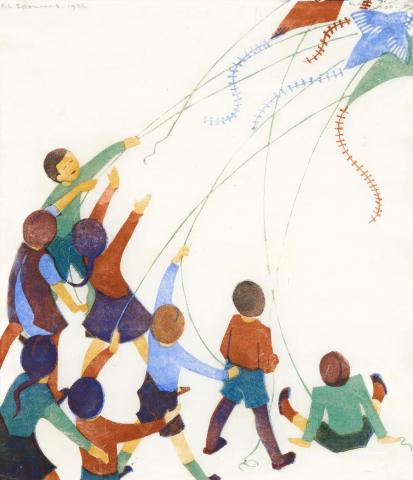KITES, 1936
ETHEL SPOWERS
colour linocut on off-white oriental tissue
29.0 x 25.0 cm
signed and dated upper left: E.L Spowers. 1936
titled and numbered upper right: Kites 7/50
Oswald Syme, Melbourne
Thence by descent
Private collection, Victoria
Exhibition of Colour Prints and Water Colours by Ethel Spowers, Grosvenor Galleries, Sydney, 10–25 July 1936, cat. 20 (as 'Flying Kites', another example)
Exhibition of Paintings and Drawings by Members of the Contemporary Art Group, Athenaeum Gallery, Melbourne, 11–22 August 1936, cat. 58 (another example)
Coppel, S., Linocuts of the Machine Age: Claude Flight and the Grosvenor School, Scolar Press, Aldershot, England, in association with the National Gallery of Australia, 1995, p. 177, cat. ES 33 (illus. p. 176, another example)
The following excerpts are from Coppel, S., Linocuts of the Machine Age: Claude Flight and the Grosvenor School, Scolar Press, Aldershot, England, in association with the National Gallery of Australia, 1995, pp. 65-68.
Ethel Spowers 'trained at the National Gallery Art School in Melbourne during the First World War ... Spowers' work in the early 1920s was largely inspired by children's fairytales and took the form of black-and white illustrations and charming watercolours. ... [Spowers travelled] to London at the end of 1928. She was joined by [Evelyn] Syme at the Grosvenor School where they both studied the linocut technique under [Claude] Flight. ... Responding eagerly to his ideas and methods, [Dorrit] Black, Spowers and Syme soon demonstrated a mastery of the medium which surpassed Flight's. The linocuts of the Australian artists from the late 1920s to the early 1930s - the heyday of Flight's reputation and influence - are marked by strong rhythms, bold colour and simplified geometric shapes. ... Spowers' style changed markedly as a result of Flight's tuition. While retaining its narrative content and often depicting children, Spowers' art became more rhythmic in expression at the Grosvenor School. ... Flight's influence on his Australian followers was technical rather than thematic. Unlike Flight and [Cyril] Power, the Australians were less attracted to the aesthetic of machine-age speed and the movement of modern life. ... Instead it was the colour harmonies and rhythmic expression that they absorbed from Flight's teaching. For Spowers her depiction of children's activities became more dynamic and lively after her exposure to the Grosvenor School.'
